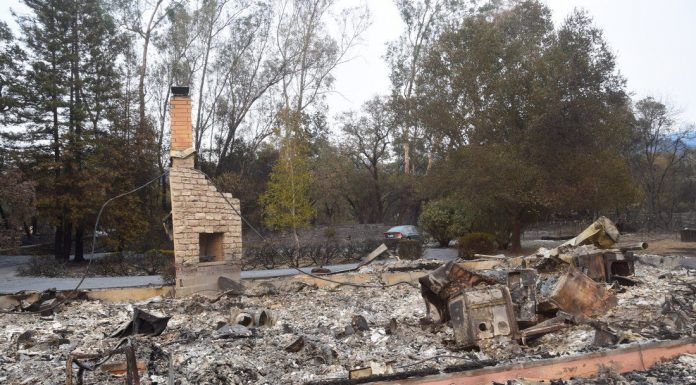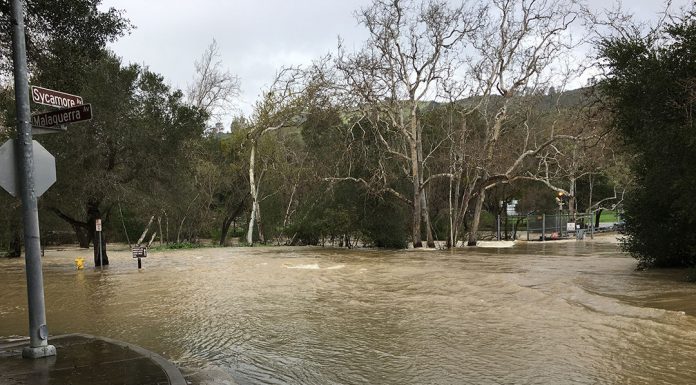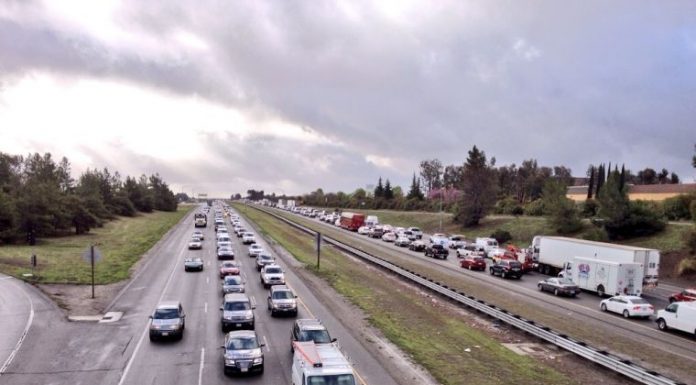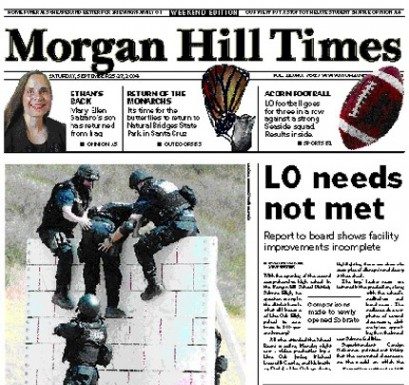Editorial: Rebuild Sonoma and Napa
A company is like a family, and when disaster strikes one part of an organization—and communities we serve—it’s felt throughout. Our newspaper group publishes seven Bay Area weeklies, including the North Bay Bohemian, based in Santa Rosa.When devastating, uncontrolled flames struck Sonoma County on Oct. 8, the Bohemian’s office closed and staff scattered because of evacuations, smoke, closed roads and in one case, a lost home. The first concern was for the staff’s safety. Everyone kept in touch with one another to ensure that everyone was accounted for. We tracked down people who hadn’t checked in.Our second mission was to put out that week’s newspaper. During times of crisis, reliable sources of information to explain events, inform and analyze are crucial.Luckily our systems are virtualized and they were put to the test. We found out that we don’t even need an office to publish a newspaper. Even though cellular and Internet connections were spotty or went out in some cases, our editors, writers, graphic artists and sales team members worked in cafes, from home or out of the homes of friends, relatives and good Samaritans, often in nearby counties.Our third item of business was to establish the Rebuild Sonoma Fund to rebuild Sonoma and Napa counties. Within a day, we registered the charitable fund with the Silicon Valley Community Foundation, created a logo and url and built a website to accept donations at rebuildsonomafund.org.Californians have a generous spirit, and we have been encouraged by the early donations.Readers can make a difference. We can help our Bay Area neighbors rebuild their lives and communities by getting money directly to the impacted areas. The fund has no administrative overhead and gets money straight to the front lines of the relief effort.We have no control over when natural disasters strike, and this is one of California’s worst ones. We do have the power to make a difference, and by contributing to the effort, we can all be part of restoring some normalcy to our neighbors who’ve had their lives turned upside down these past two weeks.Donations can be made online at RebuildSonomaFund.org.
Our View: District failed to prevent abuse
The Morgan Hill Unified School District might have saved $8.25 million and prevented the lifelong traumatization of at least three young girls if district leadership had enforced its own training procedures on how to identify and report child molesters like John Loyd, who showed a clear pattern of “grooming” some of his fifth grade students for abuse.The signs of Loyd’s favoritism toward his victims—a common trait of sexual abuse predators—were clear, and spanned years before the Paradise Valley Elementary School teacher was busted by police in 2015.An investigation by attorneys for the families of three girls—who recently settled with the district just before their lawsuit went before a jury—found that Loyd routinely played favorites with female students. He would offer them candy in exchange for hugs, and slipped them candy bars under their desks.At least two students who, luckily, did not become victims of Loyd, complained to their parents that their teacher gave this special treatment only to girls. The parents in turn complained of this behavior to both Loyd and the school principal. There is no record of these complaints in Loyd’s personnel file. No action was taken against the teacher.These and similar complaints go as far back as 2009, or three principals ago at Paradise Valley, according to the initial lawsuit.The disregard for common-sense precautions intended to keep kids safe on campus was apparently systemic while Loyd was molesting his victims. Shortly after his arrest, he told police that he was instructed by his supervisor at Paradise Elementary to work on his class’ student newspaper—the Room Nine Times—during recess and lunchtime, according to the lawsuit. This allowed him to be in his room alone with individual children on a regular basis. Somehow, he was even permitted to cover his windows with paper copies of the Room Nine Times, preventing anyone from being able to see inside.Even back in 2004, when Loyd was teaching at Nordstrom Elementary, he made inappropriate sexual remarks and contact with a girl in his class toward whom he allegedly showed so much favoritism that other students called her a “teacher’s pet.”If the district had followed its own Child Abuse Reporting Procedures—first approved by trustees in 2004 and updated in 2012—perhaps these patterns of abuse would not have continued in Loyd’s classroom for so long. This policy requires the district leadership to enact an “age-appropriate and culturally sensitive child abuse prevention curriculum” for students.No such programs seems to have been implemented, despite the district’s claims to the contrary.The abuse cited in the criminal charges against Loyd—for which he is now serving a 40-year prison term—occurred from 2012 to 2014. This was during a transition in the district’s top staff position and changes in the elected seven-member board of trustees. Wes Smith left MHUSD as superintendent in 2013. The board of trustees immediately named Betando his interim replacement, then hired him full-time in 2014 with a $225,000 annual salary.Before that, Betando served as MHUSD’s Human Resources director starting in 2012, about the time the board updated its child abuse reporting procedures.The district is not admitting it is at fault by settling with three of Loyd’s victims.But the fact that the district agreed to pay the victims $8.25 million just as the lawsuit was scheduled to be argued in front of a jury “speaks volumes,” as attorney Robert Allard told Times reporter Scott Forstner.The girls’ parents have said an even more important aspect of the settlement is MHUSD agreed to implement a predator identification training program for all staff members and students.Hopefully, MHUSD will take this requirement seriously as well as launch an independent investigation into the lapses. The superintendent should have implemented the board’s policy, and the board, as overseers responsible for the safety of the community’s children, should have been diligent about holding the superintendent responsible at annual reviews.
Our View: Santa Clara Valley embarrassingly unprepared for disaster
With all the money that’s spent in our county on flood prevention and control, it’s reasonable to expect that there would be some good plans to prevent a Katrina-style urban flood. Judging by what occurred to residents in neighborhoods to the north—in a modern city of a million people—it’s safe to conclude that local communities are not well prepared for large-scale natural disasters.The Anderson and Coyote reservoirs overtook their floodgates and water engulfed residents along the Coyote Creek, including neighborhoods just a few blocks from city hall in downtown San Jose. The interconnectedness between South Valley watersheds and nearby population centers is a fact of our modern existence. However, the information flow between water district officials and municipal emergency officials show a confused series of events, infused with misinformation and a failure to properly warn residents in affected areas.The Anderson Dam was known to be in an unsafe, overfilled state for more than two weeks prior to this week’s disaster. And although routine public announcements were issued, no effort was made to educate residents in the danger zones how to prepare for a sudden onslaught of contaminated water at their doorsteps.The botched warning systems strongly suggest that in a larger disaster—such as a seismically-triggered dam break on the fault line beneath Anderson Reservoir—the results, needless to say, would be catastrophic.The Coyote Creek flooding suggests the City of Morgan Hill might need to update its disaster evacuation plan. Morgan Hill City Manager Steve Rymer said at a recent council meeting that such a plan relies heavily on directing people out of town via U.S. 101, which is a Catch 22. The freeway was impassable for much of Tuesday, when the Coyote Canal breached under the pressure of historic creek flows and pouring rain that submerged all northbound travel lanes until the water district could repair the canal.How can a freeway located along a flood zone protected by aging facilities be relied on as a passage to safety in the event of a catastrophic, citywide deluge that might prompt widespread evacuations?As for alternate routes, all major mountain passes (Highways 129, 152 and 17) out of South County to higher ground have been closed at various times in recent days due to the rain. Many residents would be trapped on the valley floor under such conditions.Another problem is that the reservoir’s outlet pipes are too small to prevent the reservoir from reaching unsafe levels that could trigger an earthquake or, as occurred on Tuesday, a flood of population centers.We need to fix the dam, its oversight and the communication systems to get the word out. The decaying infrastructure must be modernized and the scandal-plagued district needs to rid itself of conflicts of interest, such as no-bid sweetheart multi-million dollar contracts to consultancy firms owned by spouses of district officials. Public trust is essential. Transparency, credibility and competence are minimum requirements for a public agency.
Opinion: Vote Yes on Measure B
We heard a rumor the other day: Traffic congestion is back in Santa Clara County.That's why we both support Measure B—because the traffic challenges we face in South County and Silicon Valley have become so bad that it impacts every person, family and community, including Morgan Hill. Measure B has the transportation improvements we need, and the accountability provisions we deserve. For the past three years, private and public citizens have been working with traffic engineers and transportation directors to develop a comprehensive plan that would have a positive impact on traffic relief, transit options and road repairs. The result is Measure B. Since there is no single answer to our traffic problems, Measure B is more like a jigsaw puzzle, with each transportation improvement snapping into place to add up to a comprehensive, countywide plan:• First, Measure B funds interchange improvements and improves traffic flow at 24 key interchanges on all seven highways that run through Santa Clara County. In South County, that includes interchange improvements at 101 & 25, 101 & 152 at Tenth Street and a new interchange near Saint Louise Regional Hospital. • Second, it greatly improves our nine county expressways, which carry one of every two county residents every single day, with key interchange and safety improvements. For Santa Teresa, Measure B funds road and trail improvements between DeWitt and Main.• Third, nearly $1 of every $5 are for the basics—to improve the crumbling conditions of our local streets and roads in all 15 cities and towns. In South County, this totals more than $50 million. • Fourth, it funds lifeline service and core transit service for people with disabilities, seniors, students and the working poor who depend on that core service.• Fifth, Measure B improves bicycle and pedestrian safety, especially near our schools.• Sixth, it finishes the BART extension, with the final six miles and four stations in San Jose and at Santa Clara University.• Finally, It connects the BART extension with what will be an electrified Caltrain Commuter Rail Service. Together, BART connected with Caltrain finally creates a rapid-rail-network around the entire Bay Area, linked with Morgan Hill and Gilroy with additional Caltrain service each morning and evening.For us, a key provision of Measure B is accountability. Instead of a "General Purpose Tax" that only requires a 50 percent vote, but that can be changed at any time by elected officials, Measure B intentionally calls for a two-thirds vote. That’s because this is the only way the funds can be locked in for these specific transportation improvements. In fact, the VTA Board can't change a single sentence in Measure B without a supermajority vote of 9 of the 12 board members. That protects small communities like Morgan Hill and Gilroy from being "out-voted" by the VTA Board.Neither of us are big fans of taxes, but we hate traffic even more. On Nov. 8, join us in voting Yes on Measure B. For more details, visit YesMeasureB.comCarl Guardino is CEO of the Silicon Valley Leadership Council. John Horner is Executive Director of the Morgan Hill Chamber of Commerce.
Our View: CHEERS and JEERS
CHEERS to Cecelia and Gary Ponzini, co-founders of the Edward “Boss” Prado Foundation, and their board members and countless volunteers who help the couple and their nonprofit organization provide clothing, food and other basic needs to Morgan Hill’s less fortunate residents. Cecelia and the energetic group that runs the foundation, which oversees Cecelia’s Closet and Food Pantry, even reached outside the community this week to collect donated items for families affected by the Butte Fire in northern California.JEERS to Morgan Hill Unified School District Superintendent Steve Betando and trustees for trying to pass a secret note during the Aug. 4 board meeting—an action that would likely get any of their 9,000-plus students scolded if caught trying the same thing in the middle of Civics class. Although the content of the note written by Betando was generic—“Anybody can call for a vote at any time”—he gave the impression he was trying to unduly influence the decision on the table, which had to do with the integration of sixth grade into the middle schools. He passed the note to Board President Bob Benevento, who then passed it along to colleagues. This was during a public meeting, and the trustees should have immediately disclosed the note’s contents upon seeing it.CHEERS to Sobrato High’s football team for hosting its first El Toro Bowl. In the rivalry matchup’s eight previous editions, the Bulldogs played the annual game at Live Oak High School because facilities couldn’t accommodate football at Sobrato. Thanks to efforts that allowed Sobrato to host its first home games last year, El Toro Bowl is coming to north Morgan Hill. Varsity kickoff is slated for 1:45 p.m. Saturday, Sept. 19. Good luck to both teams!JEERS to the city of Morgan Hill for the poor timing of current downtown construction projects which are causing disruptions to business and holding potential visitors to the neighborhood at bay. We know the city has been planning these projects for many years, and they have to spend the funds available for these infrastructure improvements on a tight schedule or else they lose them. But they could have implemented the projects—the Fourth Street Garage, Monterey Road streetscape, Third and Fourth street reconstruction, First Street utility upgrades, etc.—in succession instead of all at once. Now the entire downtown neighborhood is a cacophonous construction zone that is difficult to navigate on foot, on bicycle or in a car.
Our View: Attorney General must approve sale
The move by the Daughters of Charity Health System to sell Saint Louise Regional Hospital in Gilroy and De Paul Medical Center in Morgan Hill might be the Roman Catholic religious order’s best decision since it was founded in France in 1633 by St. Vincent de Paul to care for the poor.Best for the nuns, to be sure. Their questionable business model and mission to treat patients regardless of ability to pay have created a financial disaster that cannot be resuscitated in its current form.But is it best for the south Santa Clara County communities of Gilroy, Morgan Hill and San Martin, which make up most of the facilities’ service area and are home to about 75 percent of their patients?Cut through the complexities and absurdities of healthcare, politics and union and corporate egos and the simple answer is, yes.The proposed sale of the DCHS medical facilities to Prime Healthcare makes the best sense in terms of healthcare and the best business sense.The alternatives—a private equity firm or the County of Santa Clara—are iffy and, in the county’s case, unrealistic and scary. The county hospital system loses tens of millions of taxpayer dollars.The sale requires review by California Attorney General Kamala Harris, who can approve or reject the bid or approve with conditions.Harris, a superstar in state Democratic Party circles who wants to be California’s next U.S. Senator, will decide by Feb. 20. Her announced run for the seat being vacated by Barbara Boxer begs the question: will politics influence her decision about Prime’s bid to buy the DCHS facilities?We applaud the attorney general’s diligence and that of her staff—and urge her to approve the sale with conditions that will ensure continued, quality care while not being so onerous as to chase away the anointed buyer-in-waiting and put the future of South County’s heath care delivery system at risk.We also urge her to resist mixing politics into her decision, no matter how badly she wants the financial support and votes of the Service Employees International Union-United Healthcare Workers, which opposes the sale to Prime and prefers another bidder.Uions have important roles to play, but when their self-serving motivations take priority over what’s best for all the people, they dilute their importance in the discussion. After all, a union’s fiduciary responsibility is and should be to its membership.The Harris decision should not be about unions or political office. If the people of south Santa Clara County and other areas impacted by the sale of DCHS facilities—San Jose, Daly City and Half Moon Bay in northern California—are to continue to receive quality care, Harris’ decision on Prime must focus on two issues:•Will its business model keep hospital doors open?•Will Prime deliver sustained, quality care, including to the poor, that is substantially equal to or better than what DCHS provided?Prime’s record must not be discounted. Under founder Dr. Prem Reddy, a cardiologist turned hospital entrepreneur, the firm has rescued 30 hospitals, saved 35,000 jobs in nine states and won awards and the gratitude of communities.Unlike other bidders, Prime has promised to respect union contracts and pension plans, assume DCHS’s debt, spend $150 million on capital improvements and continue care to the poor. It has never closed or sold a hospital, according to Reddy and its literature.That Prime is a for-profit company should not be a deal killer. It offered better terms and is the only viable bidder that would not force DCHS to go through bankruptcy. And bankruptcy proceedings are likely if the Daughter’s system becomes insolvent or a different buyer insists on it in order to shed financial liabilities before taking over.If bankruptcy happens—a requirement if the county buys DCHS facilities—then how the system is run and to whom it is sold would be up to a bankruptcy judge and a creditors’ committee, with no local say in the matter. Could the county outbid private healthcare or equity firms that would line up to buy at liquidation prices? Arguments for approval are reasonable, unclouded by politics, give access to healthcare priority and come from a cross section of constituencies, including—tellingly—hospital workers bucking their own union.The Silicon Valley Leadership Group has endorsed the sale. So have the California Nurses Association, a lot of SEIU-UHW’s local members, the City of Gilroy and its chamber of commerce, the Gilroy Economic Development Corporation and the Morgan Hill Chamber of Commerce.Economically, DCHS employs more than 500 people, has a payroll in excess of $58 million and spends another $130 million—easily nearing $200 million a year flowing into local cash registers and bank accounts.DCHS executives and around 45 employees in its administrative operation will lose their jobs if sold and will leave with severance checks, customary in the industry—not the improper windfalls critics suggest.Arguments against the sale don’t all add up, even if some are well founded—fears of some job loss (Prime says mostly middle management positions), programs being cut and not all insurance plans accepted.Others, such as Prime being under investigation for its billing practices, mislead. Many hospitals undergo such probes and some have paid big fines. Prime says it has never been charged with wrongdoing or fined.If Harris rejects the sale and hospital doors close, it would mean long drives, even in medical emergencies, for South County residents—and even for some as far away as Hollister, which accounts for about 10 percent of Saint Louise’s patients.If Harris approves the sale, her consultants have recommended conditions that are designed to make sure quality care continues. While some are for five years, most of the conditions are suggested to last for 10 years.That’s a potential problem for Prime. Changes in the nation’s healthcare system are inevitable. The Affordable Care Act is a good example. Virtually overnight it has changed the medical landscape.In most cases, the 10-year assurances are prudent. But they raise questions: is the consultant suggesting that for a decade Prime must continue business as usual at DCHS facilities and expect better financial outcomes? And is Prime to have no flexibility to adjust if the medical landscape shifts and what seems doable now becomes impossible in the future?Approval of the sale to Prime with doable conditions that protect services is what’s in the best interest of Gilroy, Morgan Hill and San Martin.
Editorial: Cheers to the Class of 2014
Cheers to the graduates of local high schools’ class of 2014. Students, families, friends and faculty have spent the last two weeks celebrating commencement ceremonies at Live Oak High School, Ann Sobrato High School, Central High School, Oakwood School and Silicon Valley Flex Academy. We congratulate all of this year’s graduates, and wish them the best of luck as they proceed into adulthood and the next big stage of their lives—whether that’s college, the armed forces, volunteerism or new careers. Jeers to Santa Clara County registered voters for their embarrassing display of apathy at the polls in the June 3 gubernatorial primary. A dismal 20 percent of the county’s 806,000 voters showed up for the election. That’s far below election officials’ and experts’ hopeful predictions of a meager 35-percent turnout. In American democracy, voters are tasked with making important decisions that can have a profound effect on the future of their communities, neighborhoods and the entire country. When voters fail at that task and don’t even show up to the polls, they can blame themselves first when barely-elected officials break their promises or make it clear they’re not going to do their jobs. Cheers to Morgan Hill’s Outdoor Sports Center for winning the bid to host US Youth Soccer’s Region IV Presidents Cup this week, June 11 through June 15. The tournament will bring 120 boys and girls soccer teams, age 12 and up, from throughout the Western states to the southeast Morgan Hill soccer complex. The event will not only elevate the facility on Condit Road to a “prestige” it hasn’t seen before, with the eyes of the country’s largest youth soccer governing body focused on the local 38-acre complex, according to Jeff Dixon of Morgan Hill Youth Sports Alliance, the nonprofit that runs the OSC. It will also bring an economic boon worth a “conservative” estimate of $1 million to Morgan Hill, as players, coaches and soccer officials are likely to spend their down time after games eating at local restaurants, staying at local hotels, visiting Morgan Hill parks, or even bowling or at the movies.Jeers to city officials who want to move the First Street veterans monument from its current site in the median of Monterey Road in downtown Morgan Hill. Complaints of a traffic hazard and road closures during annual Memorial Day and Veterans Day ceremonies at the memorial are bunk. The intersection is no more hazardous than others, and the city has many other options to improve pedestrian safety as part of the overall plan to spruce up and redevelop the downtown. And Morgan Hill residents and officials should be proud that so many people show up to ceremonies honoring their veterans that the police have to block vehicle traffic, even if it is for a mere 45 minutes or so, twice a year.
Editorial: Trustees should curb travel expenses
It’s time for the Morgan Hill Unified School District’s seven elected trustees to exercise some fiscal restraint and set an example by cutting back on theirs use of taxpayers’ money to attend conferences and banquets in the name of “professional development.”During the 2013-2014 school year the board of education members spent more than $15,000 from the general fund on their expenses for airfare, hotel stays, meals and registration to attend events such as the California School Boards Association’s annual conference in San Diego, Chamber of Commerce breakfasts, the California Latino School Boards Association conference and other events. It’s easy to dismiss $15,000 as insignificant compared to the district’s overall $65 million general fund budget. But the trustees, who are elected by the people of Morgan Hill and are using their money to attend these events, have a responsibility to set an example. Plus, the amount spent by MHUSD trustees on these conferences and banquets is more than twice that of nearby school districts. In Morgan Hill, at the top of the list was Trustee Rick Badillo’s $4,645.70 tab, a majority coming from attending the CSBA and the California Latino School Boards Association annual conferences as well as CSBA Masters in Governance coursework.At the opposite end is Trustee Amy Porter Jensen, who did not attend a single conference and expensed not a cent from the taxpayers’ wallet.We agree with Badillo, who told reporter Scott Forstner that it’s the elected officials’ duty “to be as informed as possible on current issues affecting our district as well as the rest of the state.” However, this information seeking process does not have to come at the expense of the taxpayers. Perhaps the board could implement a policy that reimburses trustees for registration fees but not travel and hotel expenses, similar to the policy in place at Santa Clara Unified.It’s a tough pill to swallow that the CSBA conference in San Diego came at a $7,581.54 charge. Did they have to fly? A carpool drive down to Southern Calif. would have been more economical. And how about a Subway sandwich for lunch rather than hundreds of dollars in meals?And some of the events—particularly Chamber breakfasts and dinners—are simply extravagant and serve no purpose in advancing the trustees’ knowledge of technical school issues. Trustees could also use some of their $200 or so monthly stipend to pay for their meals and hotelsThe board is putting together a subcommittee of three trustees to come up with a more suitable professional development budget. That’s a productive start. Professional development is a vital component to establishing the best board —and something that should not be discouraged. But not at a $15,000 cost to the taxpayers.
Yes, Virginia, there is a Santa Claus
… Yes, Virginia, there was an editorial about the credibility of Santa Claus, appearing more than 100 years ago in The New York Sun. It was written by Francis Pharcellus Church, an assistant to the paper’s editor. A true Christmas classic, it has outlived its writer, the recipient, and the newspaper that gave it life. Its most famous phrases are often recalled and sometimes parodied.
Trustees should start a search
There are whisperings that the Morgan Hill Unified Board of Trustees is ready to offer Interim Superintendent Steve Betando a three-year contract.













